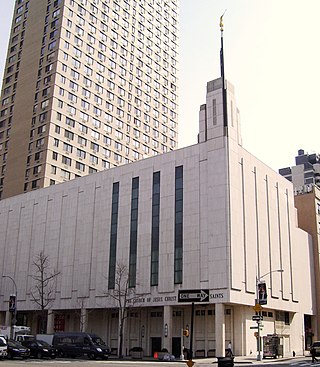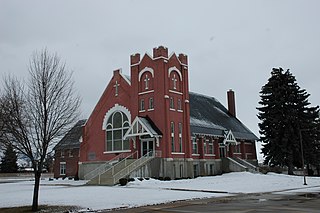A stake is an administrative unit composed of multiple congregations in certain denominations of the Latter Day Saint movement. The name "stake" derives from the Book of Isaiah: "enlarge the place of thy tent; stretch forth the curtains of thine habitation; spare not, lengthen thy cords, and strengthen thy stakes". A stake is sometimes referred to as a stake of Zion.
A ward is a local congregation in the Church of Jesus Christ of Latter-day Saints, with a smaller local congregation known as a branch.

The Vernal Utah Temple is the fifty-first temple of the Church of Jesus Christ of Latter-day Saints. The temple is located in Vernal and was the church's tenth temple built in Utah.

The Manhattan New York Temple is the 119th operating temple of the Church of Jesus Christ of Latter-day Saints. It is the second "high rise" LDS temple to be constructed, after the Hong Kong China Temple, and the third LDS temple converted from an existing building, the previous two being the Vernal Utah Temple and the Copenhagen Denmark Temple.

The Church of Jesus Christ of Latter-day Saints in California refers to the Church of Jesus Christ of Latter-day Saints and its members in California. California has the 2nd most members of the LDS Church in the United States, behind Utah. The LDS Church is the 2nd largest denomination in California, behind the Roman Catholic Church.

The Ely LDS Stake Tabernacle was built by the Church of Jesus Christ of Latter-day Saints in 1927-1928 as a church and community center in Ely, Nevada. The two-story Colonial Revival building is now owned by White Pine County and is used as a community meeting hall. The contractor for the project was Joseph Don Carlos Young, grandson of Brigham Young.

The Church of Jesus Christ of Latter-day Saints in Oregon refers to the Church of Jesus Christ of Latter-day Saints and its members in Oregon. Oregon has the 9th most members of the church of any U.S. state. Members have had considerable influence in the state throughout its contemporary history and many influential Latter-day Saints have come from Oregon, including Senator Gordon H. Smith.

In the Church of Jesus Christ of Latter-day Saints, a tabernacle is a multipurpose religious building, used for church services and conferences, and as community centers. Tabernacles were typically built as endeavors of multiple congregations, usually at the stake level. They differ from meetinghouses in scale and differ from temples in purpose.

The Malad Second Ward Tabernacle is a tabernacle and meetinghouse of the Church of Jesus Christ of Latter-day Saints located in Malad City, Idaho. It is significant for its large scale and unorthodox adaptation of architectural styles, as well as its historical importance to Oneida County, which once was among the most populated counties in Idaho. It is, along with six other buildings in Oneida County, listed on the National Register of Historic Places.

The Bear Lake Stake Tabernacle, or Paris Tabernacle is situated on main street in Paris, Idaho, is a Romanesque red sandstone meetinghouse of the Church of Jesus Christ of Latter-day Saints designed by Joseph Don Carlos Young, the son of Brigham Young built between 1884 and 1889. The tabernacle was built by Mormon pioneers of Bear Lake Valley who used horse and ox teams to haul rock quarried from Indian Creek Canyon nearly 18 miles away. After the completion of the Logan Utah Temple in 1884, the workers began construction of the tabernacle. William Budge supervised the construction. It cost $50,000 to build and seats around 2000 people.

The Randolph Tabernacle is a Victorian-styled meetinghouse for the Randolph Ward (congregation) of the Church of Jesus Christ of Latter-day Saints and is located in Randolph, Rich County, Utah. It was listed on the National Register of Historic Places on April 10, 1986.

Miles Miller was a 20th-century architect in Utah. He was a graduate of Latter Day Saint University and the University of Utah. He worked in a firm with Clifford Percy Evans and Taylor Woolley between 1917–1922 in Salt Lake City, Utah. Two of his works, the Parowan 3rd Ward Meetinghouse (1914) and Central Park Ward Chapel (1927), represent Prairie School architecture. He also designed the Carbon Stake Tabernacle which was completed in 1914.
Hyrum Conrad Pope was a German-born architect with important architectural works throughout the western United States and Canada. Pope was born in Fürth, Bavaria and immigrated to the United States as a teenager. He went to school at the Art Institute of Chicago where he was influenced in the Prairie School architectural style. In 1910, he opened an architectural firm with Harold W. Burton in Salt Lake City, Utah. Pope designed a variety of places of worship for many faiths, civic buildings and homes, some of which are listed on the National Register of Historic Places.
Harold William Burton was an early 20th-century architect with architectural works throughout the western United States and Canada. Burton was one of the most prolific architects of chapels, meetinghouses, tabernacles and temples for the Church of Jesus Christ of Latter-day Saints. In 1910 he opened an architectural firm with Hyrum Pope in Salt Lake City, Utah. They particularly appreciated Frank Lloyd Wright and the Prairie School architectural style. As young architects, Pope & Burton won design competitions for two of their better-known works, the Cardston Alberta and Laie Hawaii temples of the LDS Church. Burton moved to Los Angeles, California in 1927 to set up another office in the firm with Pope. After Pope unexpectedly died in 1939, Burton established a new firm with his son Douglas W. Burton. Together they continued to design many buildings, including some for the church, and in 1955 Harold Burton became the chief supervising architect for the LDS Church. One of his final works was the Oakland California Temple. Aside from places of worship, Burton designed civic buildings and homes. Many of his works exist today, some of which are listed on the National Register of Historic Places.

The Granite Stake Tabernacle is a tabernacle of the Church of Jesus Christ of Latter-day Saints in the Sugar House District of Salt Lake City, Utah, United States. It has historic significance to the area and was listed in the U.S. National Register of Historic Places in 2003.
Oasis Church is a Christian church in Los Angeles, California. Its building is listed as a Los Angeles Historic-Cultural Monument under the name Wilshire Christian Church Building.

The Lehi Tabernacle served as a tabernacle of The Church of Jesus Christ of Latter-day Saints from its 1910 dedication to 1920 when it was sold to the Alpine School District. The building was reestablished as a tabernacle in 1937 until its eventual 1962 demolition in downtown Lehi, Utah, United States.

The Portland Stake Tabernacle,, is a historic church building in the Richmond neighborhood of Portland, Oregon.
The architecture of the Church of Jesus Christ of Latter-day Saints includes the design and use of the church's temples, meetinghouses, historic sites, and other buildings and facilities. The LDS Church is known for its unique and often imposing architecture. The church's architecture differs based on the uses of individual buildings and varies in style throughout the world.
The Honolulu Stake Tabernacle, formerly known as the Oahu Stake Tabernacle, is a historic tabernacle and current meetinghouse of the Church of Jesus Christ of Latter-day Saints located in Honolulu, Hawaii. The tabernacle was built between 1940 and 1941, and was dedicated on August 17, 1941 by David O. McKay, second counselor in the church's First Presidency.














